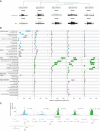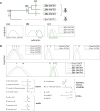Evolution of Olfactory Receptors Tuned to Mustard Oils in Herbivorous Drosophilidae
- PMID: 34963012
- PMCID: PMC8826531
- DOI: 10.1093/molbev/msab362
Evolution of Olfactory Receptors Tuned to Mustard Oils in Herbivorous Drosophilidae
Abstract
The diversity of herbivorous insects is attributed to their propensity to specialize on toxic plants. In an evolutionary twist, toxins betray the identity of their bearers when herbivores coopt them as cues for host-plant finding, but the evolutionary mechanisms underlying this phenomenon are poorly understood. We focused on Scaptomyza flava, an herbivorous drosophilid specialized on isothiocyanate (ITC)-producing (Brassicales) plants, and identified Or67b paralogs that were triplicated as mustard-specific herbivory evolved. Using in vivo heterologous systems for the expression of olfactory receptors, we found that S. flava Or67bs, but not the homologs from microbe-feeding relatives, responded selectively to ITCs, each paralog detecting different ITC subsets. Consistent with this, S. flava was attracted to ITCs, as was Drosophila melanogaster expressing S. flava Or67b3 in the homologous Or67b olfactory circuit. ITCs were likely coopted as olfactory attractants through gene duplication and functional specialization (neofunctionalization and subfunctionalization) in S. flava, a recently derived herbivore.
Keywords: Drosophila melanogaster; Scaptomyza flava; Brassicales; Or67b; SSR; chemoreceptor; evolution; gene duplication; herbivory; isothiocyanate; neofunctionalization; olfaction; olfactory receptor; olfactory specialization; specialization; subfunctionalization; wasabi.
© The Author(s) 2021. Published by Oxford University Press on behalf of the Society for Molecular Biology and Evolution.
Figures







Similar articles
-
Odorant receptors mediating avoidance of toxic mustard oils in Drosophila melanogaster are expanded in herbivorous relatives.Mol Biol Evol. 2025 Jul 4:msaf164. doi: 10.1093/molbev/msaf164. Online ahead of print. Mol Biol Evol. 2025. PMID: 40614170
-
Odorant receptors mediating avoidance of toxic mustard oils in Drosophila melanogaster are expanded in herbivorous relatives.bioRxiv [Preprint]. 2025 May 29:2024.10.08.617316. doi: 10.1101/2024.10.08.617316. bioRxiv. 2025. Update in: Mol Biol Evol. 2025 Jul 04:msaf164. doi: 10.1093/molbev/msaf164. PMID: 39416046 Free PMC article. Updated. Preprint.
-
Evolution of herbivory in Drosophilidae linked to loss of behaviors, antennal responses, odorant receptors, and ancestral diet.Proc Natl Acad Sci U S A. 2015 Mar 10;112(10):3026-31. doi: 10.1073/pnas.1424656112. Epub 2015 Jan 26. Proc Natl Acad Sci U S A. 2015. PMID: 25624509 Free PMC article.
-
Using Drosophila to study the evolution of herbivory and diet specialization.Curr Opin Insect Sci. 2016 Apr;14:66-72. doi: 10.1016/j.cois.2016.01.004. Epub 2016 Feb 1. Curr Opin Insect Sci. 2016. PMID: 27436649 Review.
-
Chemical communication in insects: the peripheral odour coding system of Drosophila melanogaster.Adv Exp Med Biol. 2012;739:59-77. doi: 10.1007/978-1-4614-1704-0_4. Adv Exp Med Biol. 2012. PMID: 22399395 Review.
Cited by
-
Shifts in bee diet breadths are associated with gene gains and losses and positive selection across olfactory receptors.G3 (Bethesda). 2025 Aug 6;15(8):jkaf105. doi: 10.1093/g3journal/jkaf105. G3 (Bethesda). 2025. PMID: 40643014 Free PMC article.
-
Gene expansion in the hawkmoth Manduca sexta drives evolution of food-associated odorant receptors.iScience. 2024 Nov 4;27(12):111317. doi: 10.1016/j.isci.2024.111317. eCollection 2024 Dec 20. iScience. 2024. PMID: 39640564 Free PMC article.
-
Preference for and resistance to a toxic sulfur volatile opens up a unique niche in Drosophila busckii.Nat Commun. 2025 Jan 17;16(1):767. doi: 10.1038/s41467-025-55971-2. Nat Commun. 2025. PMID: 39824833 Free PMC article.
-
Molecular tug-of-war: Plant immune recognition of herbivory.Plant Cell. 2022 Apr 26;34(5):1497-1513. doi: 10.1093/plcell/koac009. Plant Cell. 2022. PMID: 35026025 Free PMC article. Review.
-
Evolution of chemosensory and detoxification gene families across herbivorous Drosophilidae.bioRxiv [Preprint]. 2023 Mar 16:2023.03.16.532987. doi: 10.1101/2023.03.16.532987. bioRxiv. 2023. Update in: G3 (Bethesda). 2023 Aug 9;13(8):jkad133. doi: 10.1093/g3journal/jkad133. PMID: 36993186 Free PMC article. Updated. Preprint.
References
-
- Aurand LW, Singleton JA, Bell TA, Etchells JL.. 1966. Volatile components in the vapors of natural and distilled vinegars. J Food Sci. 31(2):172–177.
Publication types
MeSH terms
Substances
Grants and funding
LinkOut - more resources
Full Text Sources
Molecular Biology Databases

